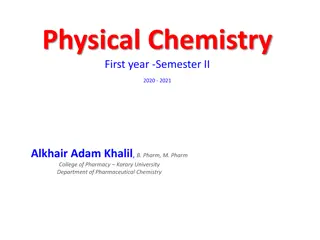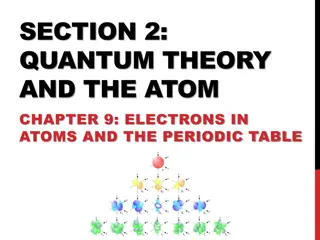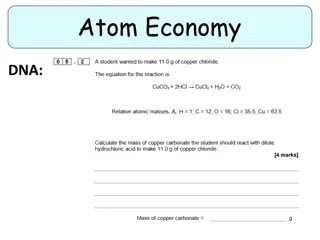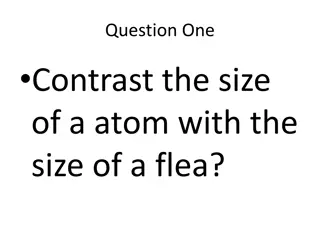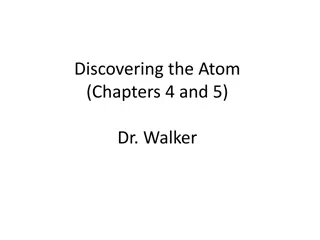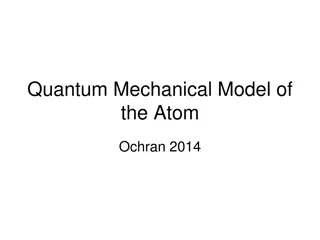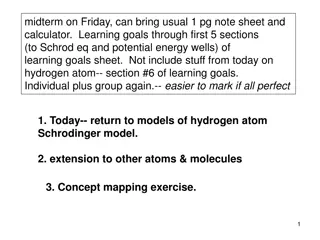Exploring Properties of Light and Models of the Atom in Chemistry
Delve into the fascinating world of light properties and atom models in chemistry. Unravel the scientific process, from successes to flaws, and master concepts like wavelength, frequency, and amplitude. Explore key experiments and models such as the Rutherford, Bohr, and DeBroglie models, as well as quantum numbers. Discover the significance of learning Quantum Mechanics and the advantages it offers in understanding atomic structures and chemical bonds.
Download Presentation

Please find below an Image/Link to download the presentation.
The content on the website is provided AS IS for your information and personal use only. It may not be sold, licensed, or shared on other websites without obtaining consent from the author. Download presentation by click this link. If you encounter any issues during the download, it is possible that the publisher has removed the file from their server.
E N D
Presentation Transcript
CHE 101 Fall 2021 Lecture 7 ab Properties of Light + Models of Atom Overview/Topics 1. Appreciate the Scientific Process (success and flaws) 2. Properties of Light 1. Wavelength, Frequency, Amplitude 2. Constructive and Destructive Interference 3. 5 Main Experiments/Models a) Rutherford Model b) Line Spectra c) Bohr Model d) DeBroglie Model e) Quantum Mechanics/Schrodinger Equation 4. 4 Quantum Numbers (what the describe) a. Principal (n) b. Angular Momentum (l) c. Magnetic (ml) d. Spin (ms) Skills to Master 1. HW 7 a b Don t! Read 1. Memorize dates 2. Memorize trivia/flavor Chapter 10
Why do we need to learn Quantum Mechanics? Review Chapter 1 (Rutherford Model) Ernst Rutherford (1911) James Chadwich (1932) Flaws in the Rutherford Model 1. Can t explain line spectra 2. e-cloud is vague 3. Doesn t explain the PT 4. Doesn t explain Ionic and Molecular Bonds Advantages of QM Describes the location of e- around an atom 1. Explains line spectra 2. Explains shape of PT 3. Explains Ionic and Molecular Bonds 4. Used 2nd semester in organic chemistry
Properties of Waves Properties of Particles 1. No mass 2. No size (spread out) a. Wavelength b. Frequency c. Amplitude 3. Continuous 4. Electromagnetic Energy 5. Add/Subtract 1. Mass 2. Size (localized) 3. Quantized 4. Kinetic Energy 5. Collide, bounce, stick together Atom
Properties of Waves (Electromagnetic Radiation) Mathematically Wavelength ( ) distance between peaks or troughs (meters, nm) ? = c = speed of light (3.00x108 m/s) Inversely Proportional (IP) Frequency ( ) number of waves/sec passing a point (waves/sec, 1/s, s-1, or Hz) Amplitude (A) distance baseline to peak (N/m2) (*we don t use this)
Different Amplitudes = Different Brightness Different Wavelength = Different Colors Constructive and Destructive Interference
Visible Light Spectrum o Short Wavelength = low frequency = low energy o Long Wavelength = high frequency = high energy High Frequency High Energy Low Frequency Low Energy
Line Spectra of the Elements Interaction of Light (waves) and Atoms (particles) 1756 - Thomas Melvill Flame Spectroscopy 1835 Charles Wheatstone ID Elements 1861 - Robert Bunsen + Gustav Kirchhoff Discover Cs, Rb 1861 - William Crookes Discovers Tl 1863 - Ferdinand Reich Discovers In Scientists not on test!
Failure of Rutherford Model 1) Fails to explain line spectra 2) If electrons orbit nucleolus they would lose energy/emit light and spiral into the nucleus Since electrons can be any distance from the nucleus then they should be able to absorb or emit any color of light leading to either: a) All colors of light are absorbed (black spectrum) b) All colors of light are emitted (rainbow spectrum) This is the exact opposite of what is observed! Electrons can be any distance from the nucleus
Bohr Model of the Atom (1913) Electrons are in quantized orbitals Predicts line spectrum Flaws (1) No reason its quantized (2) Does not work for > 1 e Explains line spectrum because only certain wavelengths (colors) of light can be absorbed or emitted because only certain orbitals are allowed. Electrons are in Quantized Orbitals Only some distances allowed N = 1, 2, 3
How Line Spectra Work Excited State Ground State Incoming light energy is absorbed as the electron moves from a low energy to high energy (close orbital to larger orbital) from the spectrum leaving black spaces at specific energy levels. Energy is emitted as electrons fall from high energy to low energy level (far orbital to close orbital), resulting only in light of specific energy being emitted.
Louis De Broglie Model Wave Particle Duality If light can behave like a wave and a particle than an electron can behave like a particle and a wave. Explained Quantization of Electron Orbitals therefore fixing Flaw (1). Model still fails for > 1 e Wave Particle Duality Light is a wave and a particle Electrons is a particle and a wave
Heisenberg Uncertainty Principle (1926) Uncertainty Principle Error in e- position is larger than the atom https://steemit.com/science/@arrjey/the-principle-of-uncertainty- and-the-double-slit-experiment
Schrodinger Equation Statistical model using wave equations to describe the location of the electron. ?? = ?? Does not violate Heisenberg 4 Principle Quantum Numbers result Schrodinger Equation Statistical Model (Ugly Math) Gives the correct answer "Anyone who is not shocked by the quantum theory does not understand it." - Niels Bohr
Coulomb's Law ? = ??1?2 Principle Quantum Number (n) ? Distance of an e- from nucleus Size of orbital Allowed Values: 1,2,3 . Shells High Energy Distance from Nucleus Low Energy
Angular Momentum Quantum Number (l) Allowed Values n = 1 then l = 0 n = 2 then l = 0 and 1 n = 3 then l = 0, 1 and 2 Etc 3D - shape of an orbital Allowed Values: 0, 1, 2, 3 (n-1) 4 shapes or sub-levels Use letters since numbers are used for n l =3 l =0 l =1 l =2 Shape of Orbitals
Magnetic Quantum Number (ml) p-orbitals (-1, 0, 1) = 3 orientations Allowed Valued: 0, 1, 2 l Orientation of the orbital or sub-levels # of orbitals s = 1 orbital p = 3 orbitals d = 5 orbitals f = 7 orbitals Use subscripts (we will ignore) d-orbitals (-2, -1, 0, 1, 2) = 5 orientations Allowed Values l = 0 ml = 0 1 orbital l = 1 ml = -1, 0, 1 3 orbitals l = 2 ml = -2, -1, 0, 1, 2 5 orbitals l = 0 ml = 0, 1, 2, 3 therefore 7 orbitals Orientation + # of Orbitals
Electron Spin Quantum Number (ms) Ms = Orbitals can hold 2 electrons s = 2 electrons p = 6 electrons d = 10 electrons f = 14 electrons 1 2 Leads to techniques like: NMR Nuclear Magnetic Resonance MIR Magnetic Imaging Resonance Two e- per orbital
Classical Mechanics Macroscopic Phenomenon Wave or Particle Continuous (all values allowed) Quantum Mechanics VS Nanoscopic Phenomenon Wave and Particle Quantized (only some values allowed) VS or




